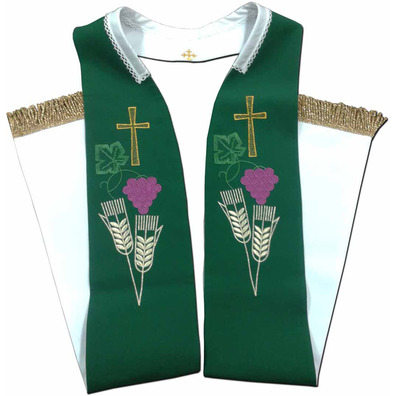Catholic clergy stole | Jerusalem Cross embroidery
Catholic clergy stole | Jerusalem Cross embroidery
- Made of 100% polyester.
- 15 cm width approx.
- 260 cm length without counting the fringe.
- For sale in two color combinations:
- White and green stole.
- White and purple stole.
- Red and purple stole.
- Red and green stole.
- One side decorated with Jerusalem Crosses embroidered with gold thread.
- Another side decorated with liturgical elements: Cross, a bunch of grapes and ears of wheat.
- Stolon topped with golden fringe.
What is a Catholic clergy stole?
The stole is a liturgical vestment worn in the Catholic Church. Usually embroidered with liturgical or Eucharistic elements such as the cross, bread and ears of wheat, wine and grapes, the chalice, etc.
It has a uniform width along its entire length, or is slightly narrower in the middle and widens at the ends.
The stole is worn mainly by deacons, priests and bishops. Deacons wear it over the left shoulder, while priests wear it from the neck to the shoulders and chest.
Bishops wear it similarly to priests, but never cross it on the chest because of the pectoral cross they wear.
During the ordination of deacons and priests, the stole is placed on them as part of the ceremony.
What is a double stole or reversible stole?
A double stole or reversible stole is a liturgical ornament used by members of the clergy of the Catholic Church.
Priests and bishops wear the stoles over their shoulders and hanging forward. The stole is a symbol of priestly authority and is used to administer the sacraments.
The double stole, unlike other stoles, has two liturgical colors, one for each of the sides of the garment. It can be used at two different times of the liturgical year.
The embroidery of the garment may vary on each side.






